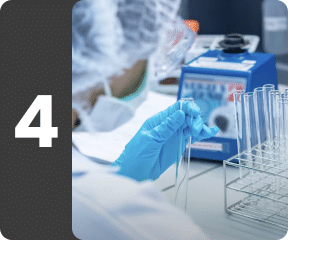
LH & Testosterone Total
Understanding LH & Testosterone Total
What is LH & Testosterone Total?
The LH & Testosterone Total test helps assess the levels of two vital hormones: luteinizing hormone (LH) and testosterone total in both males and females. These hormones play an important role in reproductive health, with Luteinizing Hormone (LH) regulating the menstrual cycle in females and sperm production in males, while testosterone is primarily responsible for male's sexual characteristics and fertility. This test is performed to detect and monitor hormonal imbalance, infertility issues and early or delayed puberty.
The LH & Testosterone Total test assesses two key hormones- Luteinizing Hormone (LH) and testosterone total. These hormones, produced by the pituitary gland and gonads (testes in males and ovaries in females), play pivotal roles in various physiological processes, important for reproductive health and overall well-being in both males and females.
In females, LH helps regulate the menstrual cycle and triggers the release of mature eggs during ovulation. LH also helps produce progesterone, a hormone essential for maintaining pregnancy. On the other hand, in males, LH stimulates testosterone production, a key hormone for the development of secondary sexual characteristics like deepening of voice, muscle growth, facial and body hair in males. Also, testosterone helps maintain sexual desire, bone health and overall vitality in males.
The LH & Testosterone Total test is recommended in females with reproductive disorders such as polycystic ovary syndrome (PCOS), menstrual irregularities, difficulty in getting pregnant, and hypogonadism (low testosterone levels). It also helps to determine ovulation time in females, evaluate hypogonadism (a condition where little or no sex hormones are produced in both males and females), and the function of the pituitary gland. In males, this test may be performed in suspected cases of low sperm count, fertility issues, or signs of low testosterone levels such as a decreased sex drive, low muscle mass, etc. By assessing the levels of LH and testosterone doctors can diagnose hormonal imbalance, guide treatment decisions, and monitor the effectiveness of interventions aimed at restoring hormonal balance and optimizing reproductive health.
In females, this test is advised on the second or third day of the menstrual cycle. For males, it can be done at any time. Additionally, inform your doctor about all the medication or supplements that you may be taking as some of them ( e..g, birth control pills) may require adjustments or temporary discontinuation before the test as these may potentially affect the test results.
Lab test results may vary across different laboratories. Don't self-medicate at home solely based on these results and talk to your doctor about your specific test results. The results will help them evaluate your medical condition; make recommendations for diet, exercise, or medication; and formulate an overall treatment plan based on your condition.
What is LH & Testosterone Total used for?
The LH & Testosterone Total test is done:
- To assess overall hormonal health in males and females
- To assess ovarian function in females.
- To evaluate menstrual irregularities in females.
- To investigate fertility problems in both males and females.
- To monitor hormone levels during infertility treatments both males and females.
- To diagnose and monitor conditions like Polycystic ovary syndrome (PCOS).
- To diagnose pituitary gland disorders
- To evaluate hypogonadism (low testosterone in males).
- To assess testicular function and sperm production in males.
- To investigate and monitor conditions affecting sexual development and delayed or early puberty in both males and females.
- To monitor hormone levels during hormone replacement therapy.
What does LH & Testosterone Total measure?
Contains 2 testsThe LH & Testosterone Total test measures the levels of two key hormones - luteinizing hormone (LH) and testosterone total in the blood. These hormones are vital for hormonal function and overall reproductive health in both males and females.
In females, LH levels rise just before ovulation to trigger the release of a mature egg while in males, LH stimulates testosterone production. On the other hand, testosterone plays a key role in the development of male reproductive tissues such as testicles and prostate, as well as promoting secondary sexual characteristics such as increased muscle and bone mass, and the growth of body hair.
The levels of these hormones are typically low during younger ages (below puberty). However, as adolescence approaches, the brain starts producing gonadotropin-releasing hormone (GnRH). GnRH stimulates the pituitary gland to release LH. These gonadotropin hormones play a crucial role in the production of sex hormones such as testosterone, which are responsible for initiating the changes of puberty and controlling reproductive function in both males and females.

Luteinising Hormone
The Luteinising Hormone test determines the level of luteinizing hormone that promotes the functioning of the gonads, i.e., testes in men and ovaries in women. LH is produced by the pituitary gland, a pea-sized gland situated at the base of the brain. The production and release of LH are controlled by a system known as the hypothalamic-pituitary-gonadal axis. A hormone called GnRH is released from the hypothalamus of the brain and binds to the cell receptors in the anterior pituitary gland, which in turn prompts the synthesis and release of luteinizing hormone. LH then travels across the blood and attaches to its target cells in the testes in men and ovaries in women to facilitate optimal sexual and reproductive activities.
Know more about Luteinising Hormone

Testosterone Total
The Testosterone Total test measures the level of testosterone hormone in the blood. Testosterone is a steroid hormone primarily produced in the testes in men, although it is also present in smaller quantities in the adrenal glands. In women, it is made in small amounts by the ovaries. It is predominantly associated with male physiology and significantly influences physiological functions in both men and women.
The pituitary gland produces luteinizing hormone (LH), which regulates testosterone production. As testosterone levels rise, LH production decreases, slowing down testosterone production. Conversely, when testosterone levels fall, LH production increases, stimulating testosterone production.
Most of the testosterone circulating in the blood gets attached to two proteins, albumin and sex hormone-binding globulin (SHBG), and some of it remains unattached, called free testosterone. Free testosterone and albumin-bound testosterone are also known as bioavailable testosterone, as they are readily available for the body to use for proper functioning.
Know more about Testosterone Total
Frequently Asked Questions about LH & Testosterone Total
Q. Why is the LH & Testosterone Total test done?
Q. When is the best time to get tested?
Q. Do I need to fast before taking the LH & Testosterone Total test?
Q. Is there any risk associated with the LH & Testosterone Total test?
Q. What are the symptoms of hormonal imbalance in females?
Q. What are the symptoms of hormonal imbalance in males?
Q. What happens when LH levels are high?
Q. What happens when LH levels are low?
Q. What are the signs of low testosterone levels in males?
Q. Can the LH & Testosterone Total test be done at home?
Q. How does Tata 1mg ensure accurate lab test results?
Book a LH & Testosterone Total test at home near me





Other tests









